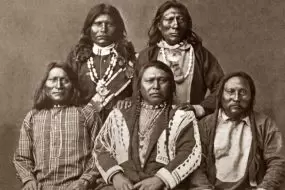An incredible explanation of how the Native American culture was destroyed and the effect on its people still today. This is a little told story that needs shared.
 Culture Clash and Native Americans
Culture Clash and Native Americans
by Becky Duplain
Prior to 1492, Native Americans were not considered a minority population. As a matter of fact, approximately 70 million Native Americans, close to the population of Europe during this time, dominated the continents of North and South America (Goldfield, 2014, p. 3). It is believed that these populations of people traveled from central and northern Siberia, across a land bridge that emerged from the current day Bering Strait. Hundreds of groups inhabited North and South America and co-existed within various tribes. Each tribe had their own culture, language or dialect, and history However, events would unfold over the next hundreds of years that would not only turn the Native Americans into a minority but into an oppressed population.
By 1492, Christopher Columbus, an Italian, was in the midst of his expedition to find the new world. When the new world was “discovered,” the meetings between Europeans and Native Americans were sometimes friendly but often times confrontational. The differences in cultures clashed. Native Americans found value in the universe, nature, plants, animals, and the stars. Their religious beliefs were passed down to younger generations through word of mouth, not in writing. These beliefs and practices were foreign to Europeans who worshipped one God in a structured church setting, through the written word of the Bible, while transferring their beliefs in writing. Ethnocentrism existed for both populations. The contrast in ways of worshipping a greater power was confusing to the two different cultures. Many Europeans assumed that Native Americans worshipped the devil. Native Americans, in turn, often found Christianity confusing. There were also different understandings of gender roles. Europeans treated men as superior to women and they disapproved of the more lenient gender roles within the Native American culture. European customs in which men did most of the agricultural work, contradicted the Native American women’s dominant role in farming, and it was assumed that men’s hunting was more for recreation than survival (Goldfield, 2014).
Could these two cultures blend into a multicultural society? In order for the indigenous population and Europeans to coexist, each side would have to look past their differences and adapt to a multicultural environment. In the early days of their coexistence, this seemed possible because of the vast amounts of land. However, the actions of the Europeans indicated that they intended to dominate the lands they claimed to have discovered. This caused a spirited resistance from the native people who desired to maintain their own culture and beliefs (Goldfield, 2014).
While battles persisted for hundreds of years between the Native Americans and white settlers, Native Americans tried to maintain their identity and lands. Yet, with influential, powerful government leaders wanting Native Americans to assimilate into the white man’s culture, the Native Americans slowly, through many occurrences, became the minority population in the United States. Through cultural imperialism, the leaders within the federal government attempted to make Native Americans into white men using various methods, including teaching them to read, teaching them to use their farming techniques, to become Christians, to become what they deemed as “civilized.” For example, Cherokee women, whose culture called for them to be in charge of the farming, were required to change their focus to domestic duties, including household management of chores and the children. It became the man’s duty to be in charge of farming. There were Native Americans that willingly assimilated into this culture and found value in the Christian religion and way of life, some even running cotton plantations and owning slaves (Richie, 2009). In trying to become “civilized” as encouraged by the federal government, during the 1820s, Cherokee leaders developed their own language and alphabet system and even their own Constitution that was modeled after the United States’ Constitution (Richie, 2009). With these changes in their culture, Cherokees were considered civilized people; however, because they occupied land desired by the U.S. government, their attempts at civilization and acculturation did not afford them equal rights by the federal or state governments.
One of the pivotal turning points in the relations between Native Americans and white settlers came when gold was discovered in Georgia, creating the first Gold Rush. Even though the gold was found on property belonging to the Native Americans, laws were passed that prohibited Native Americans from digging for gold. In addition to desiring this land for its gold, the government also wanted to take over the millions of acres of land belonging to the natives located in southwest Georgia and central Alabama and Mississippi to be used for cotton plantations (Goldfield, 2014, p. 259). In what has become known as the Trail of Tears, a result of the Indian Removal Act of 1830, President Andrew Jackson, enforced the Act by removing five tribes (the Cherokees, Creeks, Choctaws, Chickasaws, and Seminoles), who controlled this land, to relocate west of the Mississippi River (Goldfield, 2014).
From 1831 through 1847, over 68,900 Native Americans from the five tribes were forced to relocate to today’s Oklahoma (Goldfield, 2014, p. 260). This 800 mile trek took three to four months, and it is estimated that 17,000 Native Americans died as a result of this removal (Goldfield, 2014, p. 260). These deaths were most substantial among the young and old because of their frailty, causing gaps in the youngest and oldest of generations. Some Native Americans that successfully made the trip died upon arrival to the new territory due to weakness and disease from the hazards of the trail. Another consequence of the trip was in the lack of fertility of the surviving women in the tribes. The Native Americans were forced to leave what they deemed sacred – their land, the mountains, the streams, their homes. The belief that their ancestors, upon death, returned to the very land they were forced to leave made it especially difficult for them to relocate (Richie, 2009). Even after arrival to the new land, there was division within the leadership of the tribes. Some had relocated several years prior to the final removal and had already-established leadership, and it was difficult for new arrivals to assimilate into this existing governance.
The forced removal by the government allowed for the rights of Native Americans to be completely violated, causing harmful impact for many generations to come; and although this event happened generations ago, the treatment of the people forced to be removed from their homes and land has caused continuous hatred for this treatment and suffering of the Native Americans (Richie, 2009). This has become part of the history and heritage of these tribes.
Another significant event that continues to impact Native Americans today was the establishment of boarding schools by the federal government. This was the government’s attempt to again “civilize” Native Americans and strip them of their identity. As was the motto stated by Captain Richard H. Pratt, “Kill the Indian, save the man” (Richie, 2009). The boarding schools had very clear motives – to completely eradicate the Native American culture. Starting in 1819, Congress passed the Indian Civilization Act, which provided funding to support the efforts of religious groups and missionaries willing to live among Native Americans to teach them what was deemed civilized living (Richie, 2009). This led to many mission schools. These schools were initially under the control of the church in an attempt to convert Native Americans into Christians. The children of tribes were taken, many times forcibly, from their families and communities and were required to learn a new language. They were forbidden to speak their native tongue, were required to learn to read, had their hair cut, their name changed, and their medicinal practices prohibited. Their identity was essentially stripped away. The schools provided Christian religious instruction, industrial training, and very elementary education. It was not the intent of the schools to provide enough education and training for the Native Americans to be able to obtain high end jobs. The training they received prepared them for vocational jobs, like carpentry and masonry for the males and the females the knowledge of cooking, cleaning, sewing, and child care. When the children returned home, they were no longer able to speak their native language; the skills they had learned could not be used there, as it was a different culture. They were taught to be ashamed of their culture and their parents. A consequence of this acculturation was that they were never taught how to be part of a family or how to be a parent. Although some said they benefitted from the schools as it brought them out of poverty and provided an education, many believed their culture and heritage had been stripped from them (Richie, 2009).
Today, traces of the effects of these events and many other events can be attributed to the oppression faced within many Native American communities. Because of the lack of resources on the lands provided to Native Americans by the U.S. government and the oppression that has been experienced, many Native Americans have grown up in an environment of poverty and have suffered the consequences of that poverty. The impact has been social, economic, political, and cultural discrimination. Suicide, alcohol and drug abuse run rampant in the Native American community. As a matter of fact, “Native Americans are more prone to alcohol-related illnesses such as diabetes and cirrhosis of the liver than are other populations” (Kottak, 2012, p. 223). Also, preserving families has become difficult for native people, as almost two-thirds of Native Americans are now living in cities (“Native,” 2006). In general, these urban Native Americans are cut off from their extended families and tribal support systems. Health challenges for Native Americans are also causing premature death in this population. Now, new research is suggesting that historic trauma, passed down from generation to generation, may be a root cause of many of these health and social issues (“Native,” 2006). A return to the Native American culture, practicing their spirituality and native belief system offers hope that these challenges can be overcome and that Native Americans will be able to return to their peaceful, fulfilling culture (“Native,” 2006).
References
- Goldfield, David & Abbott, Carl & Anderson, Virginia DeJohn & Argersinger, Jo Ann E. & Argersinger, Peter H. & Barney, William L., (2014). The American Journey, A History of the United States. Seventh Edition, Volume 1 (to 1877). Upper Saddle River, NJ: Pearson.
- Kottak, Conrad Phillip & Kozaitis, Kathryn A., (2012). On Being Different, Diversity & Multiculturalism in the North American Mainstream. Fourth Edition. New York, NY: McGraw Hill.
- Native American Public Communications (2006, September). Indian Country Diaries, Today’s Challenges. PBS.com. Retrieved from http://www.pbs.org/indiancountry/challenges/
- Richie, Chip. (Producer). (2009). Trail of Tears [DVD]: a Native American documentary collection. Mill Creek Entertainment.

